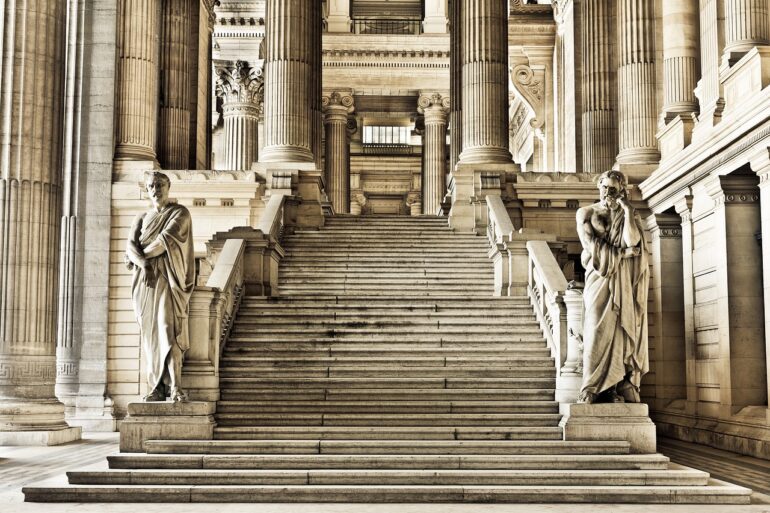Introduction to the Paris Palais de Justice
Located in the heart of the Île de la Cité, the Paris Palais de Justice is an iconic institution that bears witness to France’s judicial and historical evolution. For centuries, it has stood as the nerve center of the French justice system, hosting some of the country’s most emblematic legal proceedings. Whether you’re a visitor or a history enthusiast, discovering this building is an invitation to explore a rich and complex heritage.
Often overlooked by the general public, the Palais is a true architectural masterpiece and a powerful symbol of the French judicial system. It houses not only the Court of Cassation but also the Paris Court of Appeal and the High Court of Justice. Its symbolic and functional significance is undeniable, both historically and today.
In this article, we’ll explore the fascinating history of the Palais de Justice, its impressive architecture, its roles within the French judicial system, and the cultural and societal impact it has had. We also encourage you to visit the building in person to better understand its place in the history of Paris.
History of the Palais de Justice: From Origins to Present Day
The history of the Paris Palais de Justice stretches back several centuries, with roots in the medieval period. Originally a royal residence, the palace evolved into the center of France’s judicial administration. Its transformation began in the 13th century under the reign of Philip IV, who established the first judicial institutions there. Over the centuries, the palace underwent numerous architectural changes to accommodate the expanding needs of the judiciary.
During the French Revolution, the Palais de Justice became the scene of many significant events. It hosted famous revolutionary trials, such as those of Marie Antoinette and Robespierre. These historical moments left a lasting mark on the building, reinforcing its symbolic role in French history. At the same time, judicial reforms transformed its internal structure, laying the foundations of the modern French legal system.
In the contemporary era, the Palais continues to play a central role. It has been modernized to meet current needs while preserving its historical heritage. Recent renovations have improved infrastructure and maintained the palace’s status as a cornerstone of French justice. Thus, the Paris Palais de Justice remains a key figure in the country’s legal and historical landscape.
Architecture of the Palais de Justice: A Masterpiece of Style
The architecture of the Palais de Justice is a harmonious blend of Gothic and classical styles. Its majestic facades and lavish interiors reflect the architectural evolution across centuries. One of the building’s highlights is the Sainte-Chapelle, a Gothic gem built under Louis IX, renowned for its stunning stained glass windows that attract thousands of visitors each year.
Many of the palace’s rooms are adorned with fine sculptures and engravings, showcasing the art and craftsmanship of various periods. Restoration efforts have preserved these architectural treasures while integrating modern elements to enhance the building’s functionality. These renovations strike a balance between tradition and modernity.
Visitors to the Palais can admire unique architectural features such as the Grand Chamber, where the judges of the Court of Cassation sit, and the magnificent ceremonial staircase. These spaces, combining grandeur and solemnity, make the palace a truly exceptional place. Every corner of this building tells a story, making the Palais de Justice a silent witness to both past and present.
The Different Halls and Courts of the Palais
The Paris Palais de Justice houses several important courtrooms and judicial offices that play a critical role in the French legal system. Among them, the Criminal Chamber is one of the most prominent. This courtroom hosts major criminal trials that often have a considerable impact on French society.
Another notable space is the Salle des Pas Perdus, a vast hall where lawyers, judges, and citizens cross paths. This busy and lively area reflects the palace’s intense daily activity. It is also a space where important discussions take place and where the outcomes of numerous legal cases are shaped.
The palace also contains several specialized chambers, such as the Social Chamber and the Commercial Chamber, each dedicated to specific legal matters. These rooms, with their distinct organizations and functions, reflect the complexity and diversity of the French judicial system. Each one plays a vital role in maintaining justice and order in France.
The Judicial Role of the Palais in the French Legal System
The Paris Palais de Justice is a cornerstone of the French judicial system. It is home to several key institutions, including the Court of Cassation, the highest judicial authority in France. This court ensures the consistent interpretation of laws and guarantees their correct application across the country.
In addition to the Court of Cassation, the palace houses the Paris Court of Appeal, which reviews cases from lower courts. This court plays a vital role in ensuring fairness and justice for all citizens and is frequently involved in complex, high-profile cases, thereby reinforcing its stature.
The High Court of Justice, also located in the palace, handles major civil and criminal cases. Its mission is to deliver fair and impartial rulings and often deals with sensitive matters. Together, these institutions make the Palais de Justice an essential component of the French legal landscape, upholding the rule of law and protecting individual rights.
Major Judicial Cases Held at the Palais
Over the years, the Paris Palais de Justice has been the venue for numerous high-profile legal cases that have shaped French history. One of the most famous is the Dreyfus Affair at the end of the 19th century—a military treason case with profound political and social consequences. It not only divided French society but also raised vital questions about justice and antisemitism.
More recently, the palace has hosted trials related to financial and political scandals, such as the Clearstream affair and various corruption cases involving high-ranking political figures. These trials, often closely followed by the media, highlight the need for transparency and integrity in the judicial process.
The Palais de Justice is also the site for major criminal trials, including those related to terrorist attacks. These proceedings require heightened security and exceptional sensitivity, aiming to deliver justice to victims and their families. Each case handled here reaffirms the palace’s role as a guardian of law and justice in France.
Visiting the Palais de Justice: Practical Information
For those wishing to discover the Paris Palais de Justice, guided tours are available, offering a unique opportunity to explore this historic building and its iconic rooms. These tours provide insight into the history of French justice and the workings of the legal system. Knowledgeable guides share fascinating stories and historical facts that enrich the experience.
Due to the sensitive nature of the activities held there, access to the palace is subject to strict security regulations. Visitors are advised to check opening hours and tour details in advance. Be prepared for security checks at the entrance.
In addition to guided tours, the palace regularly hosts cultural events and temporary exhibitions that highlight various aspects of justice and Parisian history. These events offer a fresh perspective on the palace and a deeper understanding of its societal role.
The Cultural and Social Impact of the Palais de Justice
The Paris Palais de Justice has a profound influence on French culture and society. As a symbol of justice and the rule of law, it embodies the core values of the French Republic. Its imposing architecture and rich history make it a subject of interest for historians, architects, and cultural enthusiasts alike.
The palace is also a meeting place for legal professionals—lawyers, judges, and law students. It plays an educational role by offering young jurists the chance to experience judicial practices and understand the realities of legal work. It also hosts debates and discussions on major legal and social issues.
In popular culture, the Palais de Justice often appears in films, television series, and literature. It has become a symbol of Paris, on par with the Eiffel Tower or Notre-Dame. Its involvement in significant trials and its historic aura make it a landmark that continues to shape public perceptions of justice in France.
Conclusion: The Importance of the Palais de Justice in Parisian History
In conclusion, the Paris Palais de Justice is a site of great importance in French history and legal life. With its majestic architecture, critical role in the judicial system, and the major trials it has hosted, it stands as both a symbol of justice and a witness to societal change.
Visiting the Palais de Justice means diving into a rich and intricate history, uncovering the inner workings of justice, and understanding the building’s cultural and societal influence. We encourage you to explore its halls and soak in its unique atmosphere.
For those eager to deepen their understanding of the French legal system and the history of justice, the Paris Palais de Justice is an essential destination. Don’t miss the chance to visit and take part in a guided tour for an enriching and educational experience. Book your visit today and step into the captivating story of this landmark institution.
Useful links :



